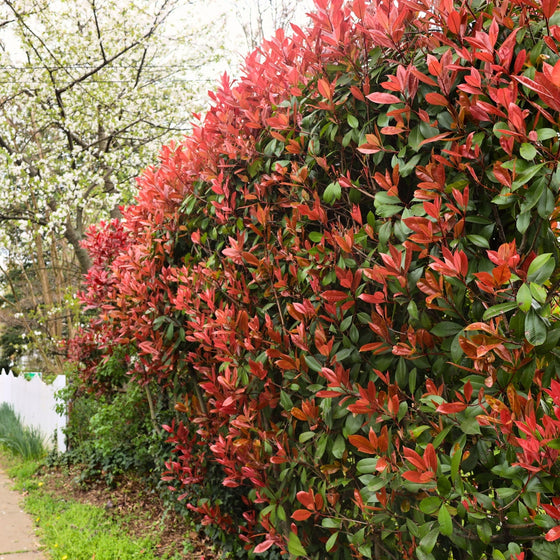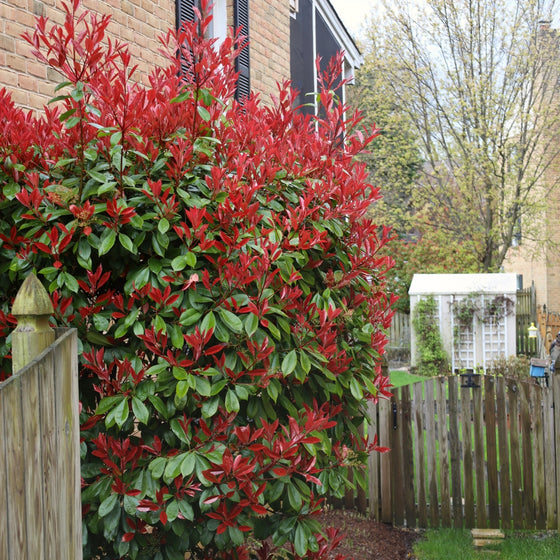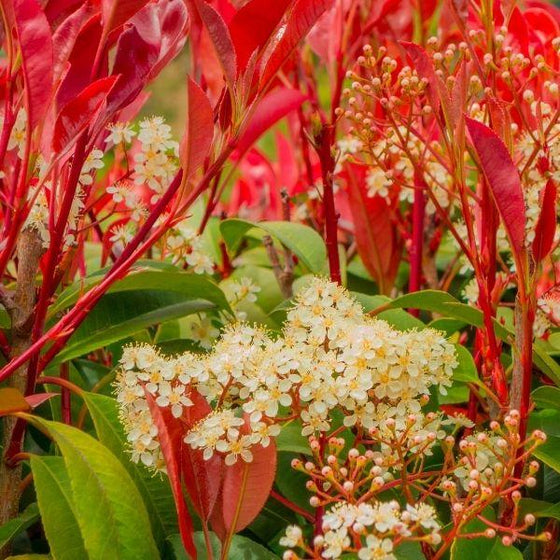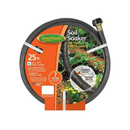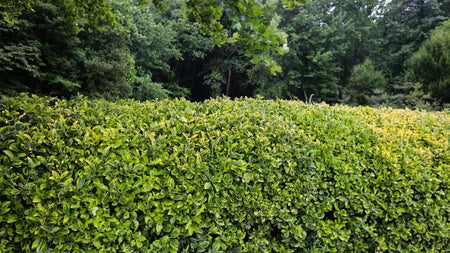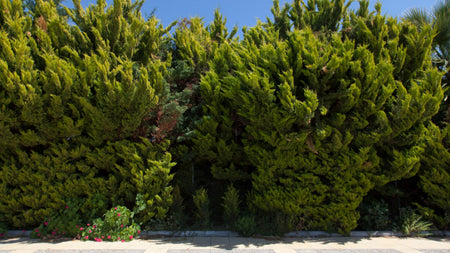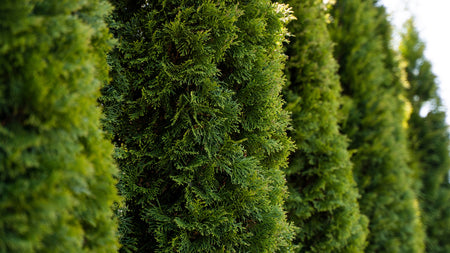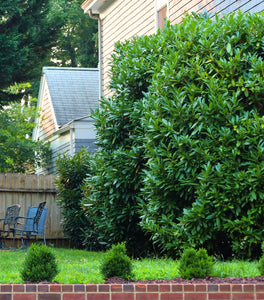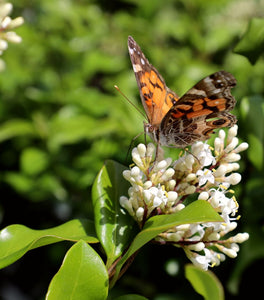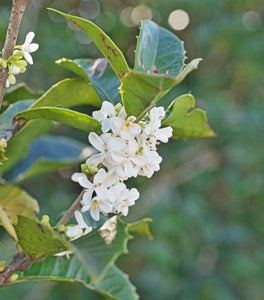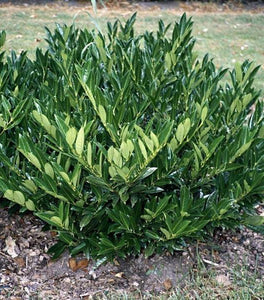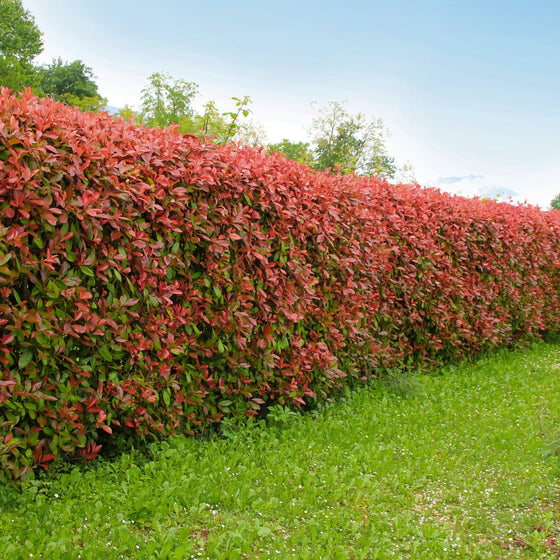
Images Depict Mature Plants
Red Tip Photinia – Fast-Growing Evergreen Hedge with Vibrant Red Foliage
A colorful evergreen for privacy and beauty.
The Red Tip Photinia (Photinia × fraseri) is a fast-growing evergreen shrub prized for its striking red new foliage that matures to a deep, glossy green. This vibrant contrast adds year-round interest, making it one of the most eye-catching hedge shrubs for landscapes. Its dense, upright form provides both beauty and function as a privacy screen or windbreak.
Perfect for hedges and large plantings.
Growing 10–15 feet tall and 8–10 feet wide, Red Tip Photinia is large enough to form a substantial barrier. Its rapid growth rate means you’ll enjoy a lush evergreen hedge in just a few seasons. Plant them in rows for a living privacy fence, or use them as foundation plantings and accents where vibrant color can shine.
Low-maintenance and resilient.
One of the best features of Red Tip Photinia is its ability to thrive in a wide range of soils and conditions. It’s hardy in USDA Zones 7–9, tolerates heat and drought once established, and grows well in both full sun and partial shade. Minimal pruning is required to maintain its natural dense shape, though it responds well to trimming for formal hedges.
Seasonal interest with evergreen reliability.
Beyond its red-to-green foliage transition, Red Tip Photinia may also produce clusters of small white flowers in spring, followed by decorative red berries in fall. With its combination of fast growth, vibrant color, and evergreen foliage, it’s a versatile shrub that enhances both formal landscapes and natural hedges.
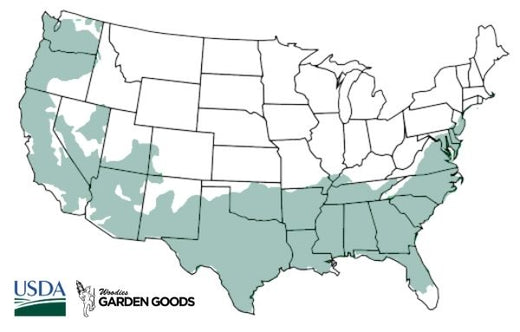
| Hardiness Zone: | 7-9 |
|---|---|
| Mature Height: | 10 to 15 feet |
| Mature Width: | 8 to 10 feet |
| Classification: | Broad-leaved evergreen shrub |
| Sunlight: | Full sun to part shade |
| Habit: | Densely branched, spreading |
| Foliage: | Rich red in spring, turning greenish-red in summer |
| Flower Color: | White in spring |
| Pruning Season: | Spring, Summer |
| Soil Condition: | Any well-drained soil |
| Water Requirements: | Water well until established |
| Uses: | Extremely attractive when used as in the mixed border, foundations, or planted in mass.; fast growing privacy plant |
How to Care for Red Tip Photinia
Before you buy a Red Tip Photinia Shrubs, make sure to read about the recommended care instructions to keep this plant healthy and thriving for years to come!

How do I plant Red Tip Photinia shrubs?
Choose a site with full sun to partial shade and well-draining soil. Dig a hole twice as wide as the root ball and just as deep. Position the shrub upright, backfill halfway, water thoroughly, then finish filling and water again. For privacy hedges, space Red Tip Photinia plants 5–8 feet apart, depending on how quickly you want them to fill in. Finish by applying a 2–3 inch mulch layer around the base to conserve moisture, regulate soil temperature, and suppress weeds. Keep mulch a few inches away from the trunk to prevent rot.
How often should I water Red Tip Photinia?
Water deeply 1–2 times per week during the first year to encourage strong root development. Soil should remain evenly moist but not soggy. Once established, Red Tip Photinia is moderately drought-tolerant and will only need supplemental watering during prolonged dry spells. Consistent watering during its establishment phase will help it grow into a dense, healthy hedge more quickly.
When and how should I fertilize Red Tip Photinia?
Fertilize in early spring with a balanced, slow-release fertilizer to encourage healthy growth and vibrant red foliage. Apply evenly around the root zone and water well to activate nutrients. A second light feeding in midsummer can help younger shrubs grow faster, while mature hedges typically only need a single annual application. Avoid overfertilizing, as this can stress the plant and encourage pests.

Does Red Tip Photinia need pruning?
Red Tip Photinia naturally forms a dense, upright habit, but pruning will enhance its shape and encourage more colorful new growth. Trim lightly in late spring or early summer after new leaves have flushed. For formal hedges, prune once or twice a year to maintain a crisp, uniform look. Always avoid heavy pruning in late fall, as tender new growth may be damaged by frost.

